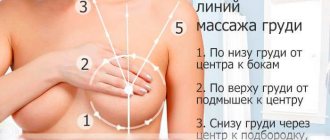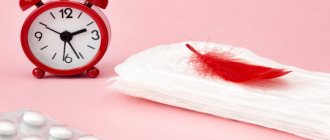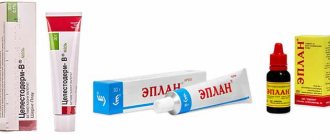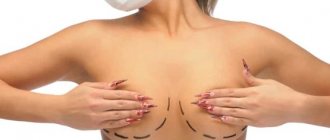What diseases cause purulent exudate?
Pus released from the mammary gland is not only a symptom of the presence of inflammation in the breast tissue, but also of malignant formations.
Doctors note that this situation is typical not only for women’s breasts, but also for men’s. Typically, purulent fluid is formed as a result of serous or purulent inflammation of the mammary glands and is distinguished by specific features:
| Options | Peculiarities |
| Consistency | Viscous. Thick. |
| Color | Grey. Green. Brown. Transparent. Bloody. White. |
| Smell | Unpleasant. |
| Compound | Cholesterol. Albumin. Leukocytes. Fats. DNA particles. Enzymes. Products of microbial activity. Impurities of skin and muscle tissue. |
Doctors identify the following diseases for which the flow of purulent exudate from the nipples is a characteristic symptom:
| Causes | Features of the painful condition |
| Mastitis | It is diagnosed in nursing women due to the formation of cracks in the nipples, when the mother does not quite correctly attach the baby to the breast or does not completely express milk. With mastitis, the discharge of pus is accompanied by other unpleasant symptoms. |
| Nipple injury and infection | Damage and infection of the nipple can be caused by: - domestic trauma; - rough stimulation of the nipple; — piercing the nipple (piercing); - incorrect technique of expressing milk. All these situations are a favorable environment for the development of infection and the formation of purulent fluid. |
| Intraductal papillomas | New growths similar to warts form on the walls of the milk ducts. Papillomas negatively affect the walls of the milk canals, contributing to their deformation. One of the signs of the disease is the flow of pus from the nipples. |
| Neoplasms of benign and malignant origin | The development of a tumor in the milk ducts also deforms their walls. The flow of pus from neoplasms indicates their significant size. |
| Mastopathy | Usually, with mastopathy, the discharge is not purulent in nature. Pus indicates an advanced stage of the disease, irritation, deformation and damage to the walls of the milk canals by growing seals. |
| Purulent cyst | The main provoking factor is hormonal disorders. |
| Nipple fissures | When a baby is placed incorrectly on the breast, microcracks are formed, which are entry points for pathogens. The activity of bacteria provokes inflammation and accumulation of purulent secretion, which then leaks from the nipple. |
| Carrying out surgery on the gland | The appearance of purulent exudate from the nipples in the postoperative period is a sign of infection during surgery, both in women and men. |
| Carbuncles and boils | The formation of such abscesses on the nipples is a rare situation, but they still occur. Gradually accumulating, purulent fluid exits through the milk ducts if there are no other options for exit. Such abscesses are extremely painful and rise above the skin surface of the gland in the form of red bumps. |
Determining the color
Based on the color of the discharge, the doctor can easily determine the disease that is causing the disease:
- Yellow. Yellow discharge with a creamy tint (colostrum) is released after childbirth in the first days. If a yellowish tint appears before menstruation and is accompanied by pain, then mastopathy can be assumed.
- Purulent. They appear when an abscess develops inside the ducts, and are observed with mastitis. Bloody discharge is dangerous. They often indicate a malignant neoplasm.
- White. Appear after taking contraceptives and with a pituitary tumor.
- Green. The dark green color is given by the pus that is released during mastitis.
- Brown. Occurs when a cyst or tumor forms in the mammary gland. A dark-colored liquid is released when it enters the milk ducts when the capillaries are damaged.
- Transparent. If they appear before menstruation, this is normal.
- Bloody. This is a sign of the development of a malignant neoplasm or damage to blood vessels.
- Black. Observed during the disintegration of a malignant neoplasm.
The amount of fluid released may be small or quite large when it is necessary to use breast pads.
Breast self-examination
In order to “catch” the onset of a disease in time, it is useful to conduct periodic breast examinations yourself. It's easy and doesn't take much time.
The examination is carried out in the first half of the monthly cycle after the end of menstruation
- Once naked to the waist, you need to stand in front of the mirror. With your hands down, carefully examine your chest to see if there is any redness, swelling, or changes in the shape of the glands. Raise your hands behind your head and examine your chest in this position.
- Gently squeezing the nipples at the bases, check for any discharge.
- Holding one hand behind your head, use gentle circular movements to examine each gland from the nipples to the armpits. Repeat the examination in the supine position.
Normally, no hardness or swelling should be felt in the chest. Any oddities should alert you - discharge, inverted nipples, bulges, changes in skin color.
You need to examine your breasts yourself once every 3-4 months, this will allow you to notice any changes in a timely manner.
If you detect discharge from the mammary glands, be sure to consult a doctor immediately. There is no need to panic or be afraid. The vast majority of glandular discharges are not cancer. The term “cancerophobia” is even common among doctors, the fear of this disease is so strong among patients. Timely diagnosis and treatment will prevent the development of complications.
What types of nipple discharge are there?
The discharge varies, which indicates the nature of the disease. It is normal to discharge milk in the form of milk during pregnancy or after childbirth. However, the rest of the discharge is pathological and has a different color, consistency, smell, taste (you just shouldn’t try them). The secret could be:
- Thick or liquid.
- Watery or slimy.
- With a subtle odor or fetid.
- White, yellow, greenish, dark green, black, brown, with blood.
- Transparent, opaque or translucent.
A milky white secretion can be secreted in both sexes. This may be a form of galactorrhea - prolactemia. It develops due to:
- Pathologies of the thyroid gland.
- Changes in climatic conditions.
- Frequent flights.
- Disorders of the pituitary-hypothalamar system.
Galactorrhea can be recognized by white or clear thick discharge from both breasts.
Other secretions may include:
- Transparent discharge. If they are not accompanied by pain, then there is no need to worry. They can occur during active physical activity, during menstruation, when wearing the wrong bra, or when taking contraceptives.
- Dark green, almost black discharge often occurs during menopause, when the breast ducts become deformed and change. The pain may not bother you. You should consult a doctor, who most often detects ectasia (plasmacytic mastitis), a disease that can lead to cancer.
- Bloody discharge often occurs with chest injuries. It should be treated with the help of doctors, otherwise the injury may abscess, leading to cystadenopapilloma or intraductal papilloma.
- Brownish-green discharge often occurs with fibrocystic disease or mastopathy. At the same time, the glands swell, causing a feeling of fullness in the chest. This requires drug treatment.
go to top
When should you see a doctor?
There are a number of symptoms, if they occur, you should immediately contact a specialist:
- discharge bothers you for more than two days;
- they contain an admixture of blood;
- the secretion comes out of only one mammary gland;
- the discharge has a thick consistency;
- peeling appears on the skin of the nipple;
- loss of symmetry (increase in size, formation of dense knots);
- the color of the nipple and the area around it changes;
- pain appears in the chest.
Discharge from the mammary glands when pressed, as well as any changes in this area should not be ignored. Timely visits to the doctor, diagnosis, and therapy will help avoid complications and serious illnesses.
Competent diagnostics
Pathological processes in the mammary gland are the sphere of influence of the mammologist. When contacting him, you will be assigned:
- mammography;
- microscopy and culture of breast discharge;
- ultrasonography;
- Magnetic resonance imaging;
- CT;
- clinical blood test;
- cytological examination;
- tests for the level of various hormones in the body;
- radiography;
- ductography;
- biopsy, etc.
These diagnostic methods allow you to examine the structure of the mammary gland, assess the degree of its functionality, identify the presence of an inflammatory or infectious process, and also eliminate the risk of developing a cancerous tumor.
In addition, the doctor will listen to the patient, analyze her complaints, trace her medical history, and find out about cases of malignant neoplasms in the woman’s family.
He will then conduct a thorough contact examination of the breast. The concentration and appearance of the discharged fluid will be assessed, as well as the presence of blood in it. The specialist will carefully examine the condition of the breast itself. First of all, he will check for compliance with the norm the size, shape, color, type of nipple, its color and the severity of any changes.
If there are nodules, lumps or painful tumors in the patient’s mammary gland, he will conduct a differential diagnosis.
What to do if there is discharge from the nipples?
If such a symptom is observed in women who are not pregnant or breastfeeding, it is necessary to find out its cause. Doctors are especially concerned about cases that occur in women over 40 years of age when there is constant discharge from one gland, mixed with blood and/or the presence of a lump. Another risk factor for breast cancer is a family history of the disease.
p, blockquote 57,0,0,0,0 –>
If a patient uses any drug for hormone replacement therapy or contraception, which is accompanied not only by discharge, but also by pain and swelling, the doctor should replace the drug with a safer one.
p, blockquote 58,0,0,0,0 –>
Laboratory research
p, blockquote 59,0,0,0,0 –>
The following tests are used for diagnosis:
p, blockquote 60,0,0,0,0 –>
- Determination of prolactin level. This hormone regulates the production of breast milk. It is determined to exclude a prolactin-secreting pituitary tumor.
- Thyroid-stimulating hormone is produced by the pituitary gland and regulates the activity of the thyroid gland. Its level is determined to exclude hypothyroidism.
- Human chorionic gonadotropin, or pregnancy test, to exclude physiological causes of this symptom.
If a malignant tumor is suspected, the doctor may prescribe a cytological examination of the secretion of the mammary glands to determine malignant cells in it. However, this study does not always help to identify a tumor, so it is rarely used.
p, blockquote 61,0,0,0,0 –>
A skin biopsy is performed for Paget's cancer of the nipple or areola. Symptoms of the disease include eczema-like skin changes (itching, cracking, dryness, flaking) and yellowish discharge from the nipple. A puncture biopsy can confirm the diagnosis.
p, blockquote 62,0,0,0,0 –>
Instrumental diagnostics
p, blockquote 63,0,0,0,0 –>
- Mammography is an x-ray examination of the mammary glands to identify compactions, calcium deposits, asymmetry, and abnormalities in the vascular pattern; used in women over 35-40 years of age and often helps detect early stage cancer.
- Ultrasound examination is prescribed to women under 35 years of age for the differential diagnosis of lumps and fluid-filled cysts, and is also used during targeted biopsies and during surgical operations.
- Ductography is the study of the gland ducts after the introduction of a radiopaque substance into them, it is necessary to identify ductal tumors and accurately determine their location.
- Magnetic resonance imaging is a safe test that detects tumors of minimal size; however, the likelihood of a false positive result is high, so this study is prescribed less frequently than mammography.
p, blockquote 64,0,0,0,0 –>
Prevention
To prevent the development of breast diseases it is necessary:
- Maintain optimal body weight and daily physical activity
- Maintain proper diet and sleep
- Avoid blows, bruises, cuts, punctures and other damage to the chest and décolleté area.
- Do not neglect natural feeding
- Give up bad habits, minimize the number of stressful situations
- Limit from excessive use of hormonal drugs
- Be examined by a mammologist twice a year
It is equally important to regularly self-palpate the glands. If there are neoplasms, they can be most clearly felt during menstruation. In everyday life, it is better to use comfortable underwear made of natural fabric. The bra should support the breasts, not compress them.
The listed recommendations have a positive effect on hormonal levels, help strengthen the immune system, and minimize the risk of pathological discharge from the mammary glands.
Preventive measures
To avoid the appearance of crusts on the nipples, you need to follow several rules of prevention:
- Take care of your health and visit your mammologist regularly. You should undergo examinations and mammograms once a year, or more often if there are threats or existing diseases.
- Follow the rules of personal hygiene: take a shower regularly and change your underwear.
- Carry out self-examinations regularly: carefully palpate each breast, moving in a circle from the center to the peripheral zones.
- Lead a healthy lifestyle: eat right, try to move, avoid stress and extreme fatigue, give up bad habits, and have a fulfilling sex life.
- Take oral contraceptives and other hormonal medications on the advice of a doctor and only under his constant supervision. If unpleasant symptoms appear, you will most likely have to stop taking it.
- Monitor the condition of the breast skin, and if necessary, moisturize it in a timely manner.
- If you have endocrine disorders, then monitor your condition, observe the dynamics of development, visit a doctor and follow all the recommendations he gives.
The appearance of crusts on the nipples can be alarming and make you worry. But this symptom does not always indicate a disorder, and some problems are not serious and can be completely solvable. It is important to notice deviations in time and eliminate their causes in order to avoid sad consequences.
If crusts appear on the nipples of a teenager or an adult, this may indicate the development of a pathological or physiological process in the body. There are many factors that can cause this phenomenon.
Reasons for the presence of discharge that looks like pus
Doctors note that white pus on the nipple is not always a purulent secretion, but only has a consistency similar to it. Therefore, it is necessary to pay attention to the following points.
Pregnancy
From about the second half of pregnancy, colostrum is produced in the mammary glands. Droplets of colostrum fluid may spontaneously be released from the nipples and dry on their surface. They have a transparent yellow tint and a thick structure, and flow out absolutely painlessly.
Breast-feeding
The appearance of milk from the nipples between feedings of the baby is considered normal, so there is no reason for alarm. Occasional discharge outside of lactation of a small amount of colorless or yellow secretion without any odor is normal.
Galactorrhea
After the final completion of breastfeeding, the female breast continues to produce milk for some time. Therefore, periodic protrusion of particles of milk fluid from the nipples is noticed for 6-12 months, and sometimes this phenomenon lasts up to two years, which is not an abnormal sign.
However, if a woman stopped feeding her child for a long time or did not breastfeed at all, then doctors talk about the manifestation of galactorrhea against the background of an increased prolactin level (responsible for lactation).
Hormonal imbalance in the female body can manifest itself against the background of:
- abortion;
- reception OK;
- miscarriage;
- gynecological diseases;
- diseases of the adrenal glands and liver.
Ectasia of milk ducts
Pathology develops in patients over 45 years of age. With this disease, a liquid secretion is formed in the structure of the glands, which is not capable of resorption. Over time, the exudate emanates out through the nipples spontaneously or when pressing on the area around the nipple.
Norm or pathology
Small amounts of clear nipple discharge may be normal. This can happen, for example, due to an impact or a fall.
It happens that before menstruation 1-2 drops of clear secretion are released, there is no cause for concern in this case. If this happens regularly, then this indicates a hormonal imbalance in the body and is a reason for medical consultation. Also, a few drops of clear liquid during sexual arousal, especially during orgasm or stimulation of the nipples during love play, may be the norm.
White or milky fluid discharged from the breast may indicate a pathology such as galactorrhea (an excess of the hormone prolactin in the body). If a woman is pregnant or breastfeeding, then this is the norm. When taking oral contraceptives, small amounts of milk-like discharge may also appear. This indicates that the drug selected is unsuitable for the woman. You should consult a doctor for the correct choice of contraceptives.
White discharge from the nipples may also indicate that there is a malfunction in one of the organs. This may be renal failure, liver failure, ovarian tumor, hypothyroidism or a mass in the pituitary gland. Purulent or green fluid indicates a breast infection. Yellow or brownish liquid may appear with mastopathy. Pathological discharge from the breast should be a reason for immediate contact with a mammologist. If the secreted fluid appeared once or twice and stopped, this does not mean that everything went away on its own, it may indicate that the pathology has become latent.
The nature of the secretion in various pathologies - general signs
For benign conditions:
p, blockquote 17,0,1,0,0 –>
- usually bilateral;
- appear when pressed;
- without impurities and lumps;
- with a sticky consistency;
- Colorless, but can also be colored - from white to yellow or green.
Bloody nipple discharge is also more often associated with benign diseases. However, they can also be caused by cancer. Therefore, when such a symptom appears, an in-depth examination by a doctor is necessary.
p, blockquote 18,0,0,0,0 –>
For malignant diseases:
p, blockquote 19,0,0,0,0 –>
- appear on one side;
- arise spontaneously, leak without pressure;
- there is clear, light, pink or bloody discharge;
- When palpated in the chest, an area of compaction is detected, and the axillary lymph nodes are enlarged.
Based on the color of the secreted fluid, one can assume a possible cause of the pathology:
p, blockquote 20,0,0,0,0 –>
- white, yellow or green discharge from the nipples is characteristic of inflammatory processes, primarily mastitis;
- dark green and thick appear when ductal cysts suppurate;
- brown ones occur with ectasia of the milk ducts;
- transparent, watery – with breast cancer;
- bloody - with cancer or papilloma.
p, blockquote 21,0,0,0,0 –>
This symptom may manifest itself in combination with other signs of breast disease:
p, blockquote 22,0,0,0,0 –>
- pain, increased sensitivity;
- palpable formation in the tissue;
- inverted nipple, uneven skin, discoloration, redness or itching of the skin;
- change in the size of one of the glands;
- fever;
- menstrual irregularities;
- nausea and vomiting;
- weakness, weight loss or gain.
p, blockquote 23,0,0,0,0 –>
What causes discharge?
Women's breasts contain milk ducts, which are located between fibrous and fatty tissue. Each canal has an opening at the top of the nipple. All women have an individual number of ducts, but the maximum number can reach up to fifteen. Through the milk ducts, not only milk and colostrum are produced, but also physiological secretion.
In the absence of diseases or the influence of external negative factors, the following condition is inherent in whitish, transparent discharge from the mammary glands:
- scanty and abundant;
- thick and watery;
- viscous or slimy.
Any uniform consistency of secretion from the canals is normal, but only against the background of a transparent shade of liquid and a small volume. If there is too much discharge, it is not recommended to postpone a visit to the mammologist.
For a certain condition, there are indicators of the norm of physiological secretion:
- Scanty, thick (one or two drops). It is noted when pressing on the chest in young girls and nulliparous women a few days before menstruation and during increased sexual arousal.
- Not very abundant, liquid. Characteristic of older women and women who have given birth, but the appearance of thick liquid is possible.
- Viscous. Colostrum occurs during gestation, breastfeeding, and for several years after cessation of lactation (individual indicator).
Nipple discharge in men
p, blockquote 51,0,0,0,0 –>
In 75% of cases this is a sign of breast cancer.
p, blockquote 52,0,0,0,0 –>
Breast cancer in men is very rare and accounts for less than 1% of all cases of malignant tumors of this organ. The disease is accompanied by the appearance of compaction and pain in the gland tissue. If discharge appears, you should contact a surgeon or oncologist as soon as possible.
p, blockquote 53,0,0,1,0 –>
In addition to the tumor, this symptom may be associated with hyperprolactinemia. It occurs quite rarely in men and is caused by a tumor of the pituitary gland.
p, blockquote 54,0,0,0,0 –>
The principles for diagnosing and treating such conditions in men are the same as in women.
p, blockquote 55,0,0,0,0 –>
p, blockquote 56,0,0,0,0 –>
What could it be?
The first alarming symptom that indicates a possible disease is discharge from the mammary gland, which occurs when pressed and independently.
The causes of discharge are:
- Physiological: at birth - engorgement of the glands with the release of colostrum, the period of pregnancy and lactation, when the gland produces milk, residual discharge after the end of feeding.
- Pathological—hormonal disorders in the body, age-related changes, inflammatory diseases of the mammary glands, tumors.
Additional symptoms of the pathological condition
Pus on the nipples does not just appear; it always indicates some abnormal processes in the glands. Typically, this pathological condition is accompanied by other clinical symptoms that cause the woman considerable discomfort:
- Swelling of the breast.
- A feeling of fullness in the area of the problematic breast.
- The manifestation of pain, the severity of which depends on the severity of the pathology.
- Temperature rises to high levels.
- Itching or burning of the breasts and nipples.
- Redness of the skin of the chest.
- Breast engorgement and the appearance of characteristic lumps in its structure.
- Hyperemia (overflow of the blood vessels of the breast).
In the presence of a malignant tumor in the mammary gland or Paget's syndrome (nipple cancer), the above-described symptoms are supplemented by other signs:
- Bloody pus from the nipples, discharged spontaneously.
- A significant increase in the volume of the gland in which the tumor is present.
- Purulent secretion flows from only one breast.
- Marked darkening of the areolar region.
- Nipple retraction is observed.
- A “lemon peel” forms on the skin of the chest.
- Peeling of the skin on the areola and nipple.
The pus that is present does not always drain spontaneously - sometimes it appears from the nipples only when pressed. Exudate can flow freely only if there is a significant accumulation of it.
Causes of pathology
The causes of pathological discharge from the mammary glands can be inflammatory and tumor processes, hormonal imbalance in the body, and diseases of the pelvic organs. Hormonal disorders occur as a result of the use of certain medications, oral contraceptives, frequent abortions, and diseases of the endocrine system.
Video: Causes of nipple discharge in women
Diseases that cause nipple discharge
Unusual discharge may appear due to the following diseases:
- Mastitis is inflammation of the breast tissue. The inflammatory process occurs as a result of bacterial infection entering the gland. This can happen during breastfeeding if cracks form on the nipples, as well as with galactorrhea (lactation not associated with breastfeeding).
- Intraductal papilloma. With this disease, growths form inside the milk duct, which are easily damaged when pressure is applied to the corresponding area of the breast. At the same time, bloody fluid is released from the nipples.
- Ectasia (dilation) of the milk ducts. This condition is not always a pathology. It occurs, for example, when breasts swell during pregnancy or before menstruation. However, in some cases the process is irreversible. Stretching of the walls of the thoracic ducts leads to the formation of cysts filled with fluid, as well as papillomas. Usually, irreversible enlargement is the result of hormonal changes that occur in the body of women after 40-45 years.
- Mastopathy. There are different varieties of this disease. All of them are associated with the proliferation of gland tissue. The main symptoms of this pathology are nagging pain in the chest and the appearance of fluid from the nipples, which has a different color and consistency.
- Galactorrhea. The disease is expressed in the fact that when pressure is applied, milk appears from the nipple, and the process has nothing to do with breastfeeding. The main causes of the disease are hormonal disorders and increased levels of prolactin in the blood. Galactorrhea can occur with diseases of the thyroid gland and pituitary gland.
- Breast cancer. When discharge from the mammary glands appears, a woman notices asymmetry of the nipples, an enlargement of one of the glands, deformation of the skin, the appearance of compactions and other signs that require urgent diagnosis and treatment.
Even more interesting:
I infected my boyfriend with HPV
The ovary is enlarged and painful
Liquid of different colors and consistency may be a concomitant sign of diseases of the pelvic organs caused by microflora disorders (thrush, intestinal dysbiosis). Discharge from the nipples occurs with ovarian diseases (chronic inflammation, polycystic disease, malignant tumor). After injuries, inflammatory processes occur in the chest, which lead to the appearance of purulent discharge from the nipple.
How dangerous is purulent nipple discharge?
Lack of timely treatment of the root cause of purulent secretion leads to aggravation of the pathological process in the mammary glands and the manifestation of severe complications:
- The disease develops into a chronic form.
- Spillage of pus into adjacent chest muscles.
- Development of abscess of the second and subsequent stages.
- Infectious-toxic shock.
- Manifestation of phlegmon.
- Formation of a fistula tract.
- Sepsis (necrotic exudate enters the lymphatic fluid and blood, and spreads throughout the body).
If purulent discharge from the nipple is accompanied by additional severe symptoms, and the woman’s well-being is worsening every day, you should not self-medicate or puncture the abscess in an attempt to remove the purulent accumulation. Illiterate actions will only worsen the clinical picture and can lead to disastrous consequences.
What to do if there is discharge from the nipples
If unusual discharge from the nipples appears, then waiting or self-medicating with folk remedies is dangerous. Under no circumstances should you use heat compresses or warm your breasts in other ways. This will only worsen the inflammatory processes in the tissues.
Do not squeeze liquid from the nipples, as this stimulates increased discharge.
You can take hormonal medications only as prescribed by a doctor. If a woman resorts to hormonal contraception, she should consult with her doctor about changing the contraceptive.
To find out the cause of the pathology and prescribe treatment, you need to visit a mammologist and undergo an examination.
Is it possible to continue breastfeeding when pus appears?
If a nursing woman develops pus from her nipple when she presses, can she continue breastfeeding? The degree of probability of maintaining lactation depends on the root cause and stage of advanced disease. Therefore, this issue must be resolved with a pediatrician and mammologist or gynecologist, based on the individual characteristics of the pathological situation.
| Nature of the condition | Peculiarities |
| For mild illness | There is every chance of maintaining breastfeeding. |
| In case of severe manifestation | A woman may be prescribed medications that suppress the lactation process, antibiotics and other potent drugs. However, this category of drugs is prescribed for a short period (up to three days), so after their discontinuation, lactation can be restored. |
If during treatment a decision was made to interrupt breastfeeding, then after recovery you can return to natural feeding by frequently applying the baby to the breast. In addition, women are advised to take teas and products that improve breast milk production.
Other features for preserving humid waste:
- If you have lactation mastitis with nipple purulent discharge in small quantities, you can feed your baby with the problem breast, but only after consulting a doctor.
- It is necessary to regularly express milk from the sore breast.
- You can breastfeed with healthy breasts without restrictions, provided that the mother is prescribed antibiotics and other medications that are compatible with breastfeeding.
- If there is an abundant presence of pus in the milk, then breastfeeding should not be done. In this case, you need to express the milk from the infected gland and pour it out. You need to express it until the pus stops coming out.
- In severe cases of lactation mastitis with relapses, when the patient has undergone surgery, drug interruption of lactation is indicated. Traditional suspension of milk secretion (tight bandaging of the breast, etc.) is contraindicated.
- Elimination of purulent abscesses (abscesses, boils, etc.) is carried out exclusively in hospital settings. Today, low-traumatic surgical methods of treatment are used, for example puncture (pulling out purulent contents with a special needle). If all medical recommendations are followed during the post-procedure period, a young mother can maintain lactation.
Features of diagnostics
If a woman discovers pus from the nipple of the mammary glands, she should immediately contact a mammologist. A particularly urgent visit to the doctor’s office is required in the following cases:
- Discharge of purulent secretion with blood.
- The flow of pus is profuse and does not stop.
Experts warn against self-medication, which often only aggravates the course of the disease and provokes the development of severe complications.
After examining the mammary glands, the doctor will prescribe a diagnostic test to clarify the root cause of the pathological phenomenon:
- X-ray of the breast.
- Ultrasound.
- Ductography.
- Mammography.
- Needle biopsy.
You will also need to pass laboratory tests:
- General blood test.
- Hormone analysis.
- Test for tumor markers.
- Cytological test of pus.
Based on the examination data obtained, a diagnosis is established and a treatment regimen is developed.
What treatment is indicated for the presence of pus?
Doctors advise against self-treatment, especially if the symptomatic manifestations are severe. First of all, it is necessary to identify the nature of the disease that led to the formation of pus, and only then decide on therapy.
However, there are situations when it is not possible to visit a doctor’s office in the next few hours. In this case, you can use external medications to alleviate the condition.
How to remove pus from a nipple at home? The following medications help:
- Vishnevsky ointment.
- Levomekol.
- Ichthyol ointment.
- Solcoseryl.
- Bepanten.
- Panthenol.
- Baneocin.
Even after successful use of external remedies, you should consult a doctor at the first opportunity.
Treatment against diseases
Features of therapy depend on what pathological processes cause the appearance of purulent secretion from the nipples:
- Inflammation. For mastitis, anti-inflammatory and antiseptic drugs are prescribed, and in severe situations, surgical intervention is used.
- Bacterial infections. Treatment with antibiotics and, in some cases, hormonal agents is recommended.
- Intraductal papilloma. It can be cured surgically (excision of the affected area of the breast is performed).
- Surgery. It is performed in situations where it is necessary to open a boil or remove a tumor in the breast tissue.
- Malignant tumors, including Paget's disease. A mastectomy of both glands is prescribed or only one formation is removed.
Use of medications
| Drugs | Drug effect | Name |
| Nonsteroidal anti-inflammatory drugs | Reduce pain. Relieves swelling. Suppress the inflammatory process. | Nimesulide. Diclofenac. Indomethacin. |
| Analgesics | Relieves pain. | Analgin. Tempalgin. Paracetamol. |
| Antibiotics | Inhibits the activity of pathogenic organisms. | Amikacin. Cefazolin. Isepamycin. Tobramycin. Cephalexin. Kanamycin. |
The appearance of purulent discharge from the nipple is an alarming symptom that is characteristic of many serious diseases. If a woman detects pus discharge, she should immediately consult a doctor.
Pregnant and nursing mothers should be especially careful about their mammary glands. The sooner the cause of the pathological condition is identified and appropriate treatment is carried out, the fewer negative consequences for the body will be in the future.
Is treatment necessary?
Therapy is prescribed only after a comprehensive examination. If the nipples become crusty due to a physiological process, only proper hygiene is recommended.
If an inflammatory process is detected during mastitis and injuries, antibacterial drugs and anti-inflammatory drugs are prescribed: Amoxiclav, Cephalexime, Levomekolevaya, Heparin ointments.
If the process of formation of a dry substance appeared during breastfeeding and does not cause discomfort, women are recommended to use only healing creams: Boroplus, Bepanten. Any medications pass into breast milk and can be dangerous for the baby.
If the problem is caused by a hormonal imbalance, a course of corrective therapy with appropriate medications is prescribed. In case of severe cancer, surgical intervention with partial or complete removal of breast tissue is prescribed.
When crusts first appear on the skin of the mammary glands, they must be carefully monitored. If there is the slightest growth or transformation to a different color, you should consult a doctor. Prompt diagnosis will make it possible to get rid of the pathology in the early stages.
Ivanova Svetlana
General practitioner of the second category, transfusiologist, 29 years of experience
Diagnosis and treatment of problems with the musculoskeletal system (lower leg) and abdomen.
- pain and discomfort in the abdomen;
- bruises and injuries of the lower leg;
- cough, chest pain;
- acute respiratory infections, ARVI;
- food poisoning;
- cold;
- runny nose;
- general malaise;
- headache;
- aching joints;
- elevated temperature.
- Diploma in the specialty “General Medicine (Treatment and Prevention)”, Chuvash State University named after. I.N. Ulyanova, Faculty of Medicine (1990)
- Internship in the specialty “Selected Issues of Therapy”, Kazan State Medical Academy (1996)
Refresher courses
- “Nephrology issues for therapists”, State Institute for Advanced Training of Physicians named after V.I. Lenin (1995)
- “Therapy”, Kazan State Medical Academy (2001)
- “Transfusiology”, Russian Medical Academy of Postgraduate Education of the Ministry of Health of the Russian Federation (2003)
- “Therapy and Pulmonology”, St. Petersburg Medical Academy of Postgraduate Education of the Federal Agency for Health and Social Development (2006)
- “Transfusiology”, St. Petersburg Medical Academy of Postgraduate Education of the Federal Agency for Health and Social Development (2007)
- “Transfusiology”, Institute for Advanced Medical Studies of the Ministry of Health and Social Development of Chuvashia (2012)
- “Therapy”, Institute for Advanced Medical Studies of the Ministry of Health and Social Development of Chuvashia (2013)
- “Therapy”, Peoples' Friendship University of Russia (2017)
Place of work: MedCenterService clinic on Kurskaya











